Critical Appraisal of Research Article on Substance Abuse Treatment
VerifiedAdded on 2020/10/22
|11
|2741
|272
AI Summary
This assignment involves critically evaluating a research study on substance abuse treatment, focusing on the methods used by the researchers, including data analysis and thematic analysis. The study's conclusions are also analyzed, with attention to its implications for practice. The assignment aims to demonstrate an understanding of qualitative research methodologies and their applications in healthcare.
Contribute Materials
Your contribution can guide someone’s learning journey. Share your
documents today.
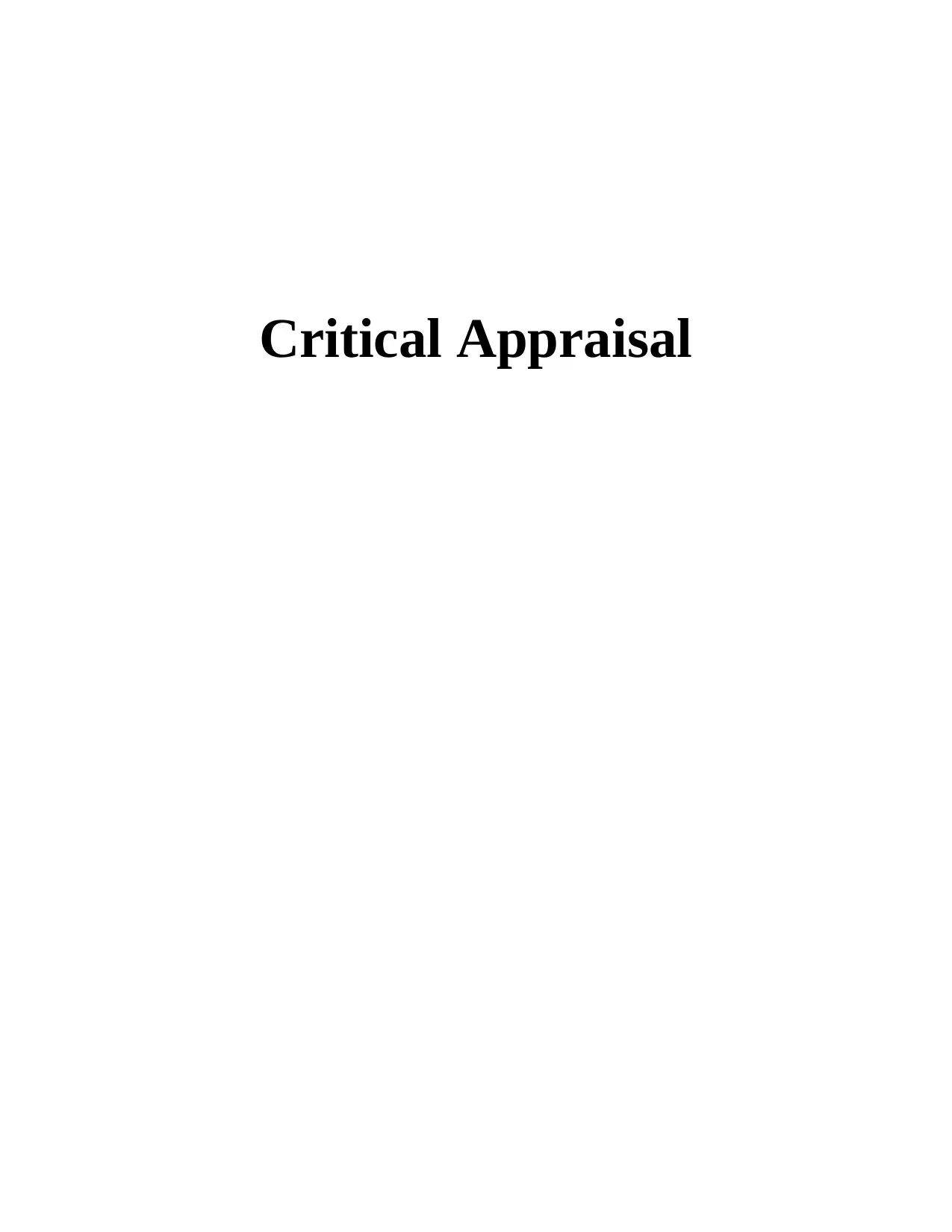
Critical Appraisal
Secure Best Marks with AI Grader
Need help grading? Try our AI Grader for instant feedback on your assignments.
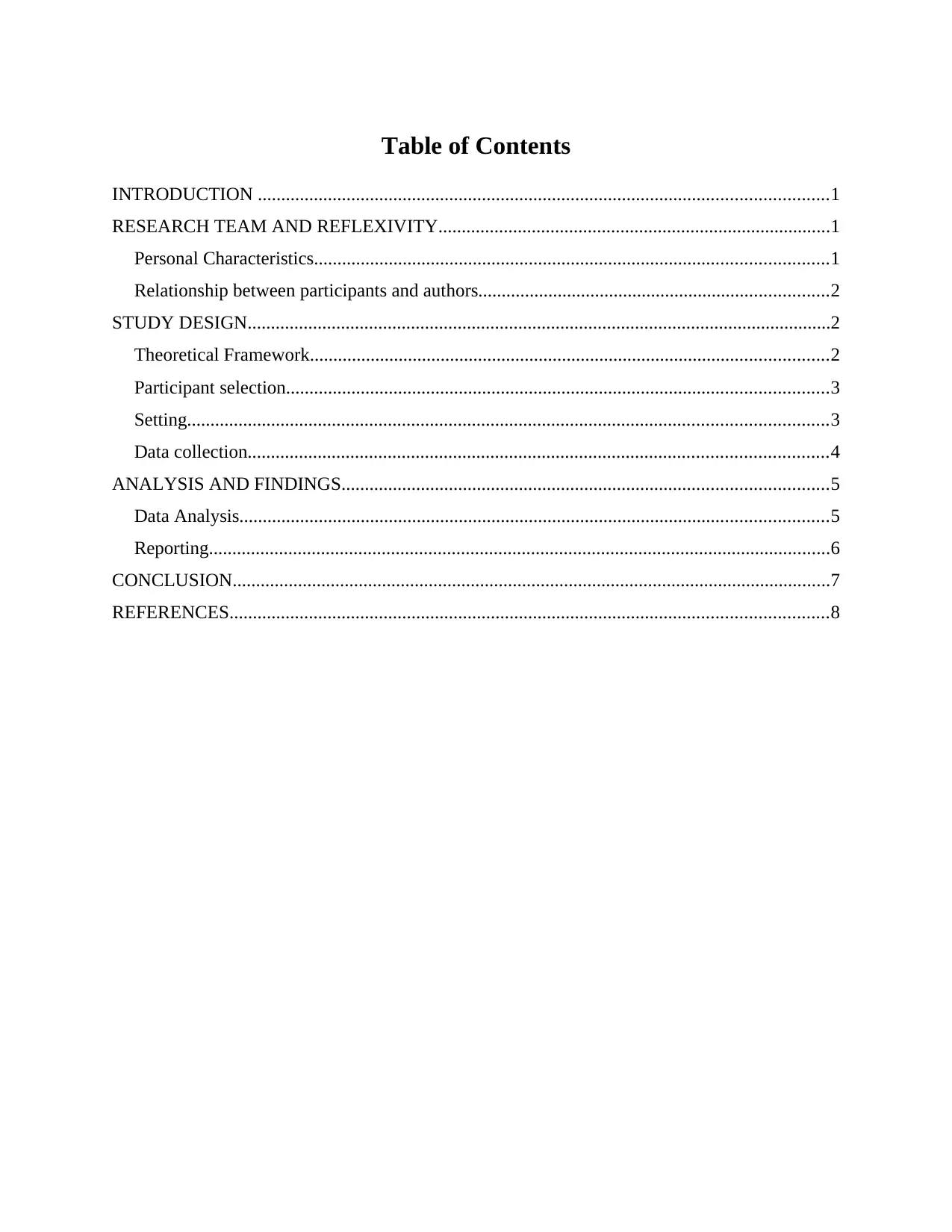
Table of Contents
INTRODUCTION ..........................................................................................................................1
RESEARCH TEAM AND REFLEXIVITY....................................................................................1
Personal Characteristics..............................................................................................................1
Relationship between participants and authors...........................................................................2
STUDY DESIGN.............................................................................................................................2
Theoretical Framework...............................................................................................................2
Participant selection....................................................................................................................3
Setting.........................................................................................................................................3
Data collection............................................................................................................................4
ANALYSIS AND FINDINGS........................................................................................................5
Data Analysis..............................................................................................................................5
Reporting.....................................................................................................................................6
CONCLUSION................................................................................................................................7
REFERENCES................................................................................................................................8
INTRODUCTION ..........................................................................................................................1
RESEARCH TEAM AND REFLEXIVITY....................................................................................1
Personal Characteristics..............................................................................................................1
Relationship between participants and authors...........................................................................2
STUDY DESIGN.............................................................................................................................2
Theoretical Framework...............................................................................................................2
Participant selection....................................................................................................................3
Setting.........................................................................................................................................3
Data collection............................................................................................................................4
ANALYSIS AND FINDINGS........................................................................................................5
Data Analysis..............................................................................................................................5
Reporting.....................................................................................................................................6
CONCLUSION................................................................................................................................7
REFERENCES................................................................................................................................8

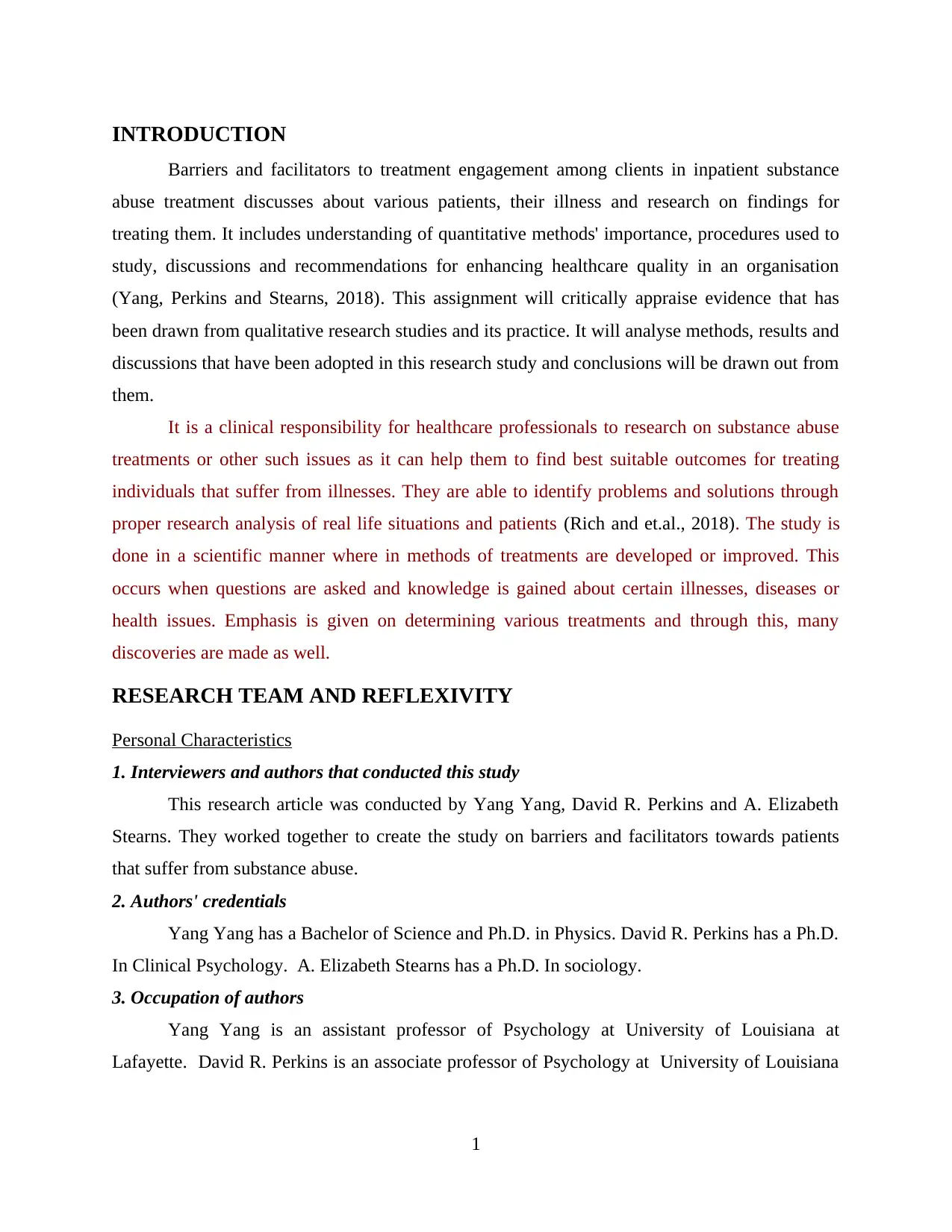
INTRODUCTION
Barriers and facilitators to treatment engagement among clients in inpatient substance
abuse treatment discusses about various patients, their illness and research on findings for
treating them. It includes understanding of quantitative methods' importance, procedures used to
study, discussions and recommendations for enhancing healthcare quality in an organisation
(Yang, Perkins and Stearns, 2018). This assignment will critically appraise evidence that has
been drawn from qualitative research studies and its practice. It will analyse methods, results and
discussions that have been adopted in this research study and conclusions will be drawn out from
them.
It is a clinical responsibility for healthcare professionals to research on substance abuse
treatments or other such issues as it can help them to find best suitable outcomes for treating
individuals that suffer from illnesses. They are able to identify problems and solutions through
proper research analysis of real life situations and patients (Rich and et.al., 2018). The study is
done in a scientific manner where in methods of treatments are developed or improved. This
occurs when questions are asked and knowledge is gained about certain illnesses, diseases or
health issues. Emphasis is given on determining various treatments and through this, many
discoveries are made as well.
RESEARCH TEAM AND REFLEXIVITY
Personal Characteristics
1. Interviewers and authors that conducted this study
This research article was conducted by Yang Yang, David R. Perkins and A. Elizabeth
Stearns. They worked together to create the study on barriers and facilitators towards patients
that suffer from substance abuse.
2. Authors' credentials
Yang Yang has a Bachelor of Science and Ph.D. in Physics. David R. Perkins has a Ph.D.
In Clinical Psychology. A. Elizabeth Stearns has a Ph.D. In sociology.
3. Occupation of authors
Yang Yang is an assistant professor of Psychology at University of Louisiana at
Lafayette. David R. Perkins is an associate professor of Psychology at University of Louisiana
1
Barriers and facilitators to treatment engagement among clients in inpatient substance
abuse treatment discusses about various patients, their illness and research on findings for
treating them. It includes understanding of quantitative methods' importance, procedures used to
study, discussions and recommendations for enhancing healthcare quality in an organisation
(Yang, Perkins and Stearns, 2018). This assignment will critically appraise evidence that has
been drawn from qualitative research studies and its practice. It will analyse methods, results and
discussions that have been adopted in this research study and conclusions will be drawn out from
them.
It is a clinical responsibility for healthcare professionals to research on substance abuse
treatments or other such issues as it can help them to find best suitable outcomes for treating
individuals that suffer from illnesses. They are able to identify problems and solutions through
proper research analysis of real life situations and patients (Rich and et.al., 2018). The study is
done in a scientific manner where in methods of treatments are developed or improved. This
occurs when questions are asked and knowledge is gained about certain illnesses, diseases or
health issues. Emphasis is given on determining various treatments and through this, many
discoveries are made as well.
RESEARCH TEAM AND REFLEXIVITY
Personal Characteristics
1. Interviewers and authors that conducted this study
This research article was conducted by Yang Yang, David R. Perkins and A. Elizabeth
Stearns. They worked together to create the study on barriers and facilitators towards patients
that suffer from substance abuse.
2. Authors' credentials
Yang Yang has a Bachelor of Science and Ph.D. in Physics. David R. Perkins has a Ph.D.
In Clinical Psychology. A. Elizabeth Stearns has a Ph.D. In sociology.
3. Occupation of authors
Yang Yang is an assistant professor of Psychology at University of Louisiana at
Lafayette. David R. Perkins is an associate professor of Psychology at University of Louisiana
1
Secure Best Marks with AI Grader
Need help grading? Try our AI Grader for instant feedback on your assignments.
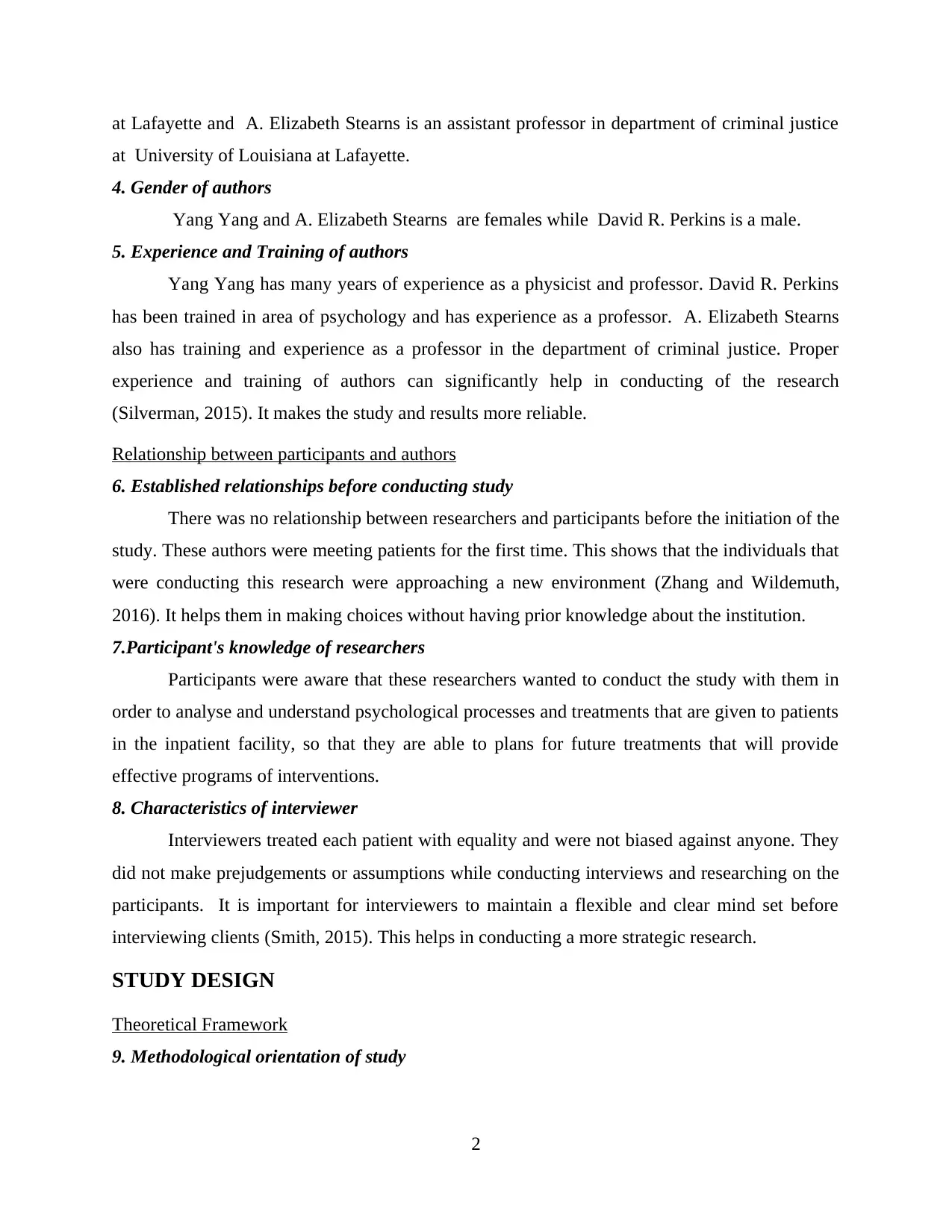
at Lafayette and A. Elizabeth Stearns is an assistant professor in department of criminal justice
at University of Louisiana at Lafayette.
4. Gender of authors
Yang Yang and A. Elizabeth Stearns are females while David R. Perkins is a male.
5. Experience and Training of authors
Yang Yang has many years of experience as a physicist and professor. David R. Perkins
has been trained in area of psychology and has experience as a professor. A. Elizabeth Stearns
also has training and experience as a professor in the department of criminal justice. Proper
experience and training of authors can significantly help in conducting of the research
(Silverman, 2015). It makes the study and results more reliable.
Relationship between participants and authors
6. Established relationships before conducting study
There was no relationship between researchers and participants before the initiation of the
study. These authors were meeting patients for the first time. This shows that the individuals that
were conducting this research were approaching a new environment (Zhang and Wildemuth,
2016). It helps them in making choices without having prior knowledge about the institution.
7.Participant's knowledge of researchers
Participants were aware that these researchers wanted to conduct the study with them in
order to analyse and understand psychological processes and treatments that are given to patients
in the inpatient facility, so that they are able to plans for future treatments that will provide
effective programs of interventions.
8. Characteristics of interviewer
Interviewers treated each patient with equality and were not biased against anyone. They
did not make prejudgements or assumptions while conducting interviews and researching on the
participants. It is important for interviewers to maintain a flexible and clear mind set before
interviewing clients (Smith, 2015). This helps in conducting a more strategic research.
STUDY DESIGN
Theoretical Framework
9. Methodological orientation of study
2
at University of Louisiana at Lafayette.
4. Gender of authors
Yang Yang and A. Elizabeth Stearns are females while David R. Perkins is a male.
5. Experience and Training of authors
Yang Yang has many years of experience as a physicist and professor. David R. Perkins
has been trained in area of psychology and has experience as a professor. A. Elizabeth Stearns
also has training and experience as a professor in the department of criminal justice. Proper
experience and training of authors can significantly help in conducting of the research
(Silverman, 2015). It makes the study and results more reliable.
Relationship between participants and authors
6. Established relationships before conducting study
There was no relationship between researchers and participants before the initiation of the
study. These authors were meeting patients for the first time. This shows that the individuals that
were conducting this research were approaching a new environment (Zhang and Wildemuth,
2016). It helps them in making choices without having prior knowledge about the institution.
7.Participant's knowledge of researchers
Participants were aware that these researchers wanted to conduct the study with them in
order to analyse and understand psychological processes and treatments that are given to patients
in the inpatient facility, so that they are able to plans for future treatments that will provide
effective programs of interventions.
8. Characteristics of interviewer
Interviewers treated each patient with equality and were not biased against anyone. They
did not make prejudgements or assumptions while conducting interviews and researching on the
participants. It is important for interviewers to maintain a flexible and clear mind set before
interviewing clients (Smith, 2015). This helps in conducting a more strategic research.
STUDY DESIGN
Theoretical Framework
9. Methodological orientation of study
2
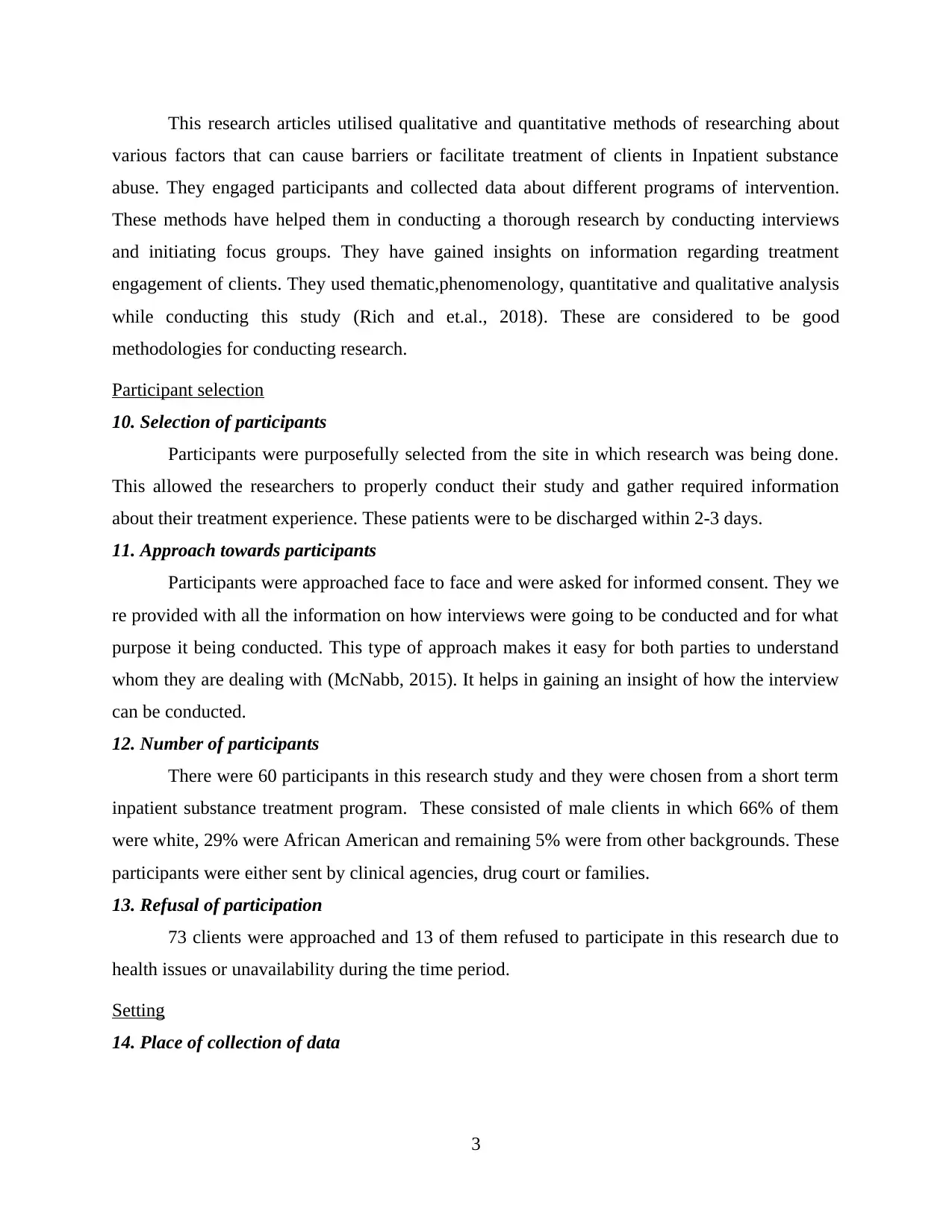
This research articles utilised qualitative and quantitative methods of researching about
various factors that can cause barriers or facilitate treatment of clients in Inpatient substance
abuse. They engaged participants and collected data about different programs of intervention.
These methods have helped them in conducting a thorough research by conducting interviews
and initiating focus groups. They have gained insights on information regarding treatment
engagement of clients. They used thematic,phenomenology, quantitative and qualitative analysis
while conducting this study (Rich and et.al., 2018). These are considered to be good
methodologies for conducting research.
Participant selection
10. Selection of participants
Participants were purposefully selected from the site in which research was being done.
This allowed the researchers to properly conduct their study and gather required information
about their treatment experience. These patients were to be discharged within 2-3 days.
11. Approach towards participants
Participants were approached face to face and were asked for informed consent. They we
re provided with all the information on how interviews were going to be conducted and for what
purpose it being conducted. This type of approach makes it easy for both parties to understand
whom they are dealing with (McNabb, 2015). It helps in gaining an insight of how the interview
can be conducted.
12. Number of participants
There were 60 participants in this research study and they were chosen from a short term
inpatient substance treatment program. These consisted of male clients in which 66% of them
were white, 29% were African American and remaining 5% were from other backgrounds. These
participants were either sent by clinical agencies, drug court or families.
13. Refusal of participation
73 clients were approached and 13 of them refused to participate in this research due to
health issues or unavailability during the time period.
Setting
14. Place of collection of data
3
various factors that can cause barriers or facilitate treatment of clients in Inpatient substance
abuse. They engaged participants and collected data about different programs of intervention.
These methods have helped them in conducting a thorough research by conducting interviews
and initiating focus groups. They have gained insights on information regarding treatment
engagement of clients. They used thematic,phenomenology, quantitative and qualitative analysis
while conducting this study (Rich and et.al., 2018). These are considered to be good
methodologies for conducting research.
Participant selection
10. Selection of participants
Participants were purposefully selected from the site in which research was being done.
This allowed the researchers to properly conduct their study and gather required information
about their treatment experience. These patients were to be discharged within 2-3 days.
11. Approach towards participants
Participants were approached face to face and were asked for informed consent. They we
re provided with all the information on how interviews were going to be conducted and for what
purpose it being conducted. This type of approach makes it easy for both parties to understand
whom they are dealing with (McNabb, 2015). It helps in gaining an insight of how the interview
can be conducted.
12. Number of participants
There were 60 participants in this research study and they were chosen from a short term
inpatient substance treatment program. These consisted of male clients in which 66% of them
were white, 29% were African American and remaining 5% were from other backgrounds. These
participants were either sent by clinical agencies, drug court or families.
13. Refusal of participation
73 clients were approached and 13 of them refused to participate in this research due to
health issues or unavailability during the time period.
Setting
14. Place of collection of data
3
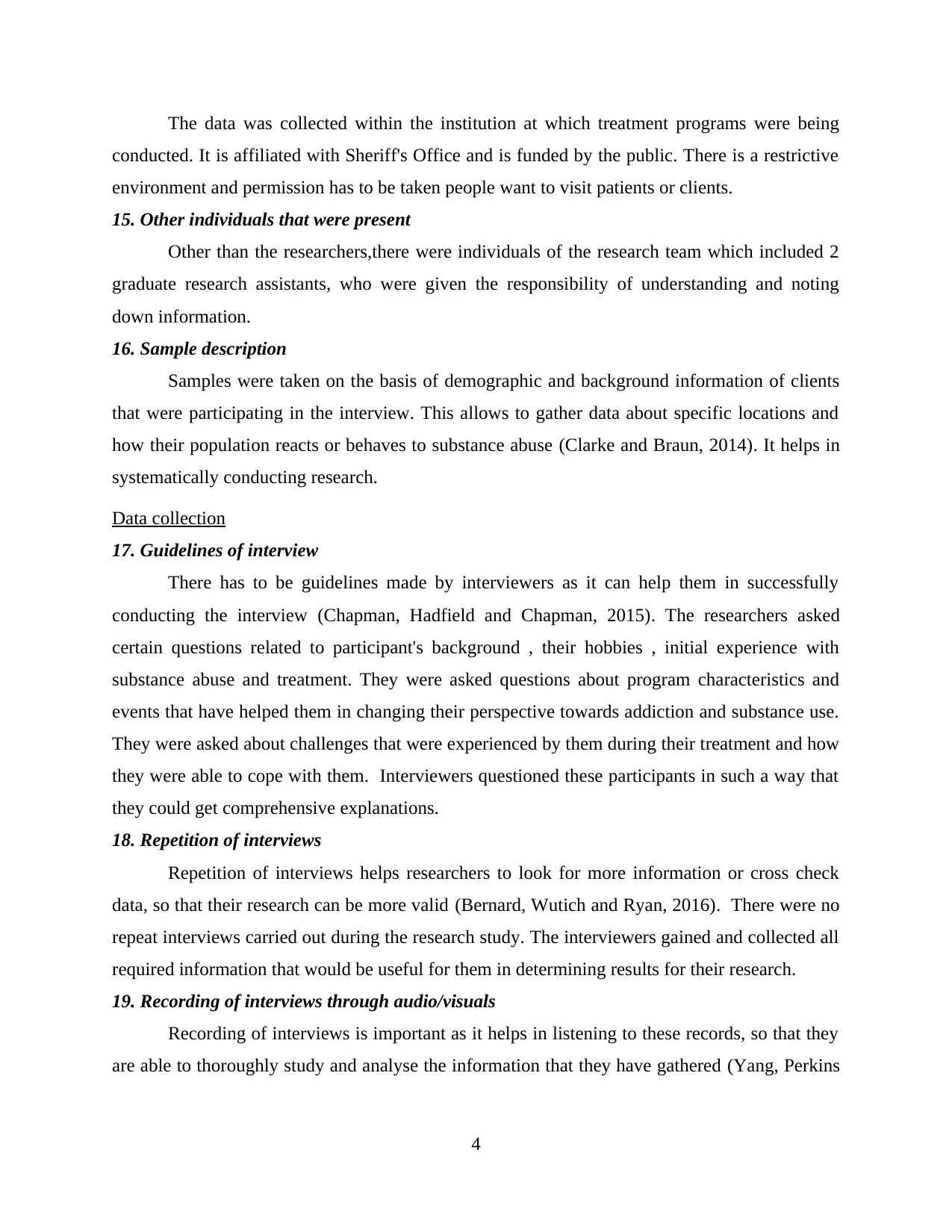
The data was collected within the institution at which treatment programs were being
conducted. It is affiliated with Sheriff's Office and is funded by the public. There is a restrictive
environment and permission has to be taken people want to visit patients or clients.
15. Other individuals that were present
Other than the researchers,there were individuals of the research team which included 2
graduate research assistants, who were given the responsibility of understanding and noting
down information.
16. Sample description
Samples were taken on the basis of demographic and background information of clients
that were participating in the interview. This allows to gather data about specific locations and
how their population reacts or behaves to substance abuse (Clarke and Braun, 2014). It helps in
systematically conducting research.
Data collection
17. Guidelines of interview
There has to be guidelines made by interviewers as it can help them in successfully
conducting the interview (Chapman, Hadfield and Chapman, 2015). The researchers asked
certain questions related to participant's background , their hobbies , initial experience with
substance abuse and treatment. They were asked questions about program characteristics and
events that have helped them in changing their perspective towards addiction and substance use.
They were asked about challenges that were experienced by them during their treatment and how
they were able to cope with them. Interviewers questioned these participants in such a way that
they could get comprehensive explanations.
18. Repetition of interviews
Repetition of interviews helps researchers to look for more information or cross check
data, so that their research can be more valid (Bernard, Wutich and Ryan, 2016). There were no
repeat interviews carried out during the research study. The interviewers gained and collected all
required information that would be useful for them in determining results for their research.
19. Recording of interviews through audio/visuals
Recording of interviews is important as it helps in listening to these records, so that they
are able to thoroughly study and analyse the information that they have gathered (Yang, Perkins
4
conducted. It is affiliated with Sheriff's Office and is funded by the public. There is a restrictive
environment and permission has to be taken people want to visit patients or clients.
15. Other individuals that were present
Other than the researchers,there were individuals of the research team which included 2
graduate research assistants, who were given the responsibility of understanding and noting
down information.
16. Sample description
Samples were taken on the basis of demographic and background information of clients
that were participating in the interview. This allows to gather data about specific locations and
how their population reacts or behaves to substance abuse (Clarke and Braun, 2014). It helps in
systematically conducting research.
Data collection
17. Guidelines of interview
There has to be guidelines made by interviewers as it can help them in successfully
conducting the interview (Chapman, Hadfield and Chapman, 2015). The researchers asked
certain questions related to participant's background , their hobbies , initial experience with
substance abuse and treatment. They were asked questions about program characteristics and
events that have helped them in changing their perspective towards addiction and substance use.
They were asked about challenges that were experienced by them during their treatment and how
they were able to cope with them. Interviewers questioned these participants in such a way that
they could get comprehensive explanations.
18. Repetition of interviews
Repetition of interviews helps researchers to look for more information or cross check
data, so that their research can be more valid (Bernard, Wutich and Ryan, 2016). There were no
repeat interviews carried out during the research study. The interviewers gained and collected all
required information that would be useful for them in determining results for their research.
19. Recording of interviews through audio/visuals
Recording of interviews is important as it helps in listening to these records, so that they
are able to thoroughly study and analyse the information that they have gathered (Yang, Perkins
4
Paraphrase This Document
Need a fresh take? Get an instant paraphrase of this document with our AI Paraphraser
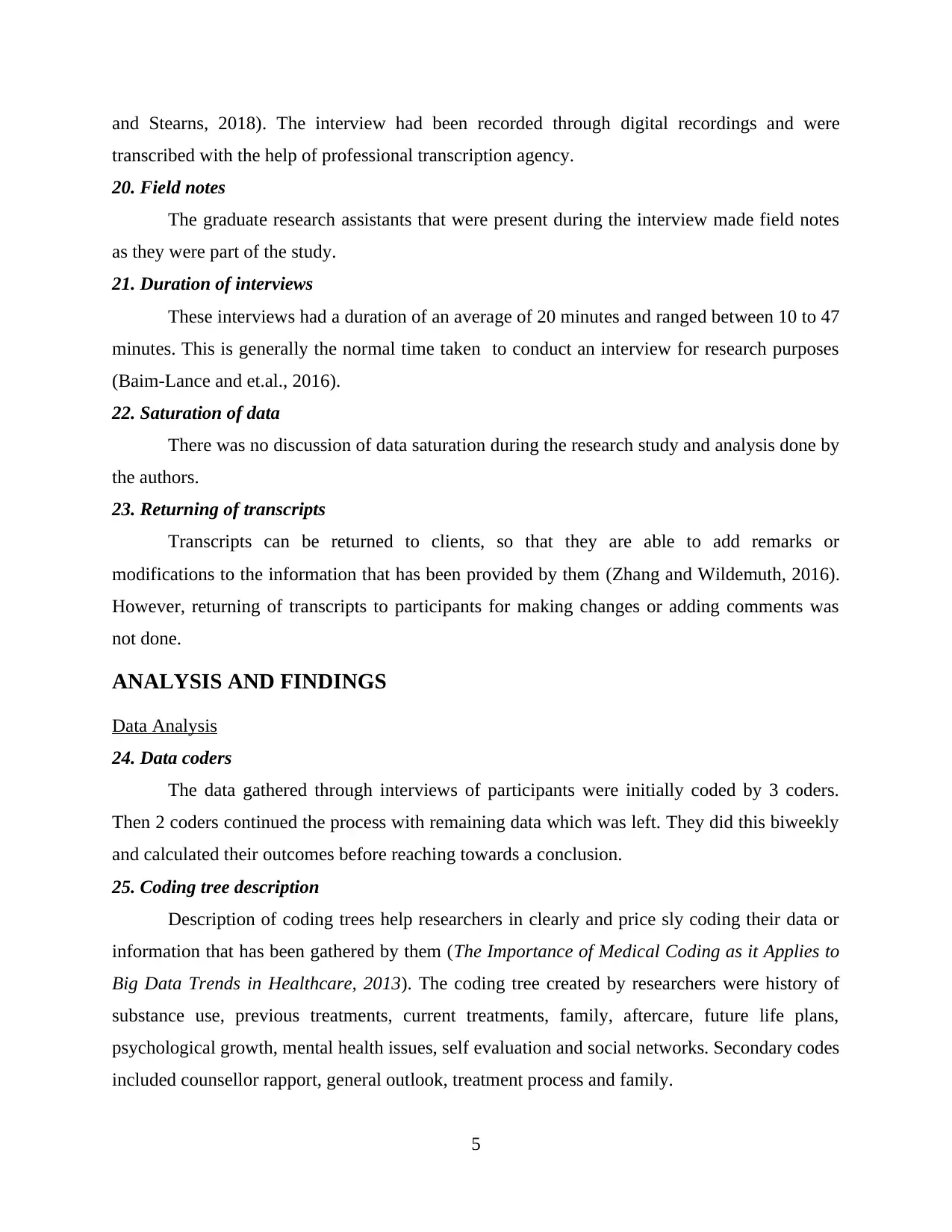
and Stearns, 2018). The interview had been recorded through digital recordings and were
transcribed with the help of professional transcription agency.
20. Field notes
The graduate research assistants that were present during the interview made field notes
as they were part of the study.
21. Duration of interviews
These interviews had a duration of an average of 20 minutes and ranged between 10 to 47
minutes. This is generally the normal time taken to conduct an interview for research purposes
(Baim-Lance and et.al., 2016).
22. Saturation of data
There was no discussion of data saturation during the research study and analysis done by
the authors.
23. Returning of transcripts
Transcripts can be returned to clients, so that they are able to add remarks or
modifications to the information that has been provided by them (Zhang and Wildemuth, 2016).
However, returning of transcripts to participants for making changes or adding comments was
not done.
ANALYSIS AND FINDINGS
Data Analysis
24. Data coders
The data gathered through interviews of participants were initially coded by 3 coders.
Then 2 coders continued the process with remaining data which was left. They did this biweekly
and calculated their outcomes before reaching towards a conclusion.
25. Coding tree description
Description of coding trees help researchers in clearly and price sly coding their data or
information that has been gathered by them (The Importance of Medical Coding as it Applies to
Big Data Trends in Healthcare, 2013). The coding tree created by researchers were history of
substance use, previous treatments, current treatments, family, aftercare, future life plans,
psychological growth, mental health issues, self evaluation and social networks. Secondary codes
included counsellor rapport, general outlook, treatment process and family.
5
transcribed with the help of professional transcription agency.
20. Field notes
The graduate research assistants that were present during the interview made field notes
as they were part of the study.
21. Duration of interviews
These interviews had a duration of an average of 20 minutes and ranged between 10 to 47
minutes. This is generally the normal time taken to conduct an interview for research purposes
(Baim-Lance and et.al., 2016).
22. Saturation of data
There was no discussion of data saturation during the research study and analysis done by
the authors.
23. Returning of transcripts
Transcripts can be returned to clients, so that they are able to add remarks or
modifications to the information that has been provided by them (Zhang and Wildemuth, 2016).
However, returning of transcripts to participants for making changes or adding comments was
not done.
ANALYSIS AND FINDINGS
Data Analysis
24. Data coders
The data gathered through interviews of participants were initially coded by 3 coders.
Then 2 coders continued the process with remaining data which was left. They did this biweekly
and calculated their outcomes before reaching towards a conclusion.
25. Coding tree description
Description of coding trees help researchers in clearly and price sly coding their data or
information that has been gathered by them (The Importance of Medical Coding as it Applies to
Big Data Trends in Healthcare, 2013). The coding tree created by researchers were history of
substance use, previous treatments, current treatments, family, aftercare, future life plans,
psychological growth, mental health issues, self evaluation and social networks. Secondary codes
included counsellor rapport, general outlook, treatment process and family.
5
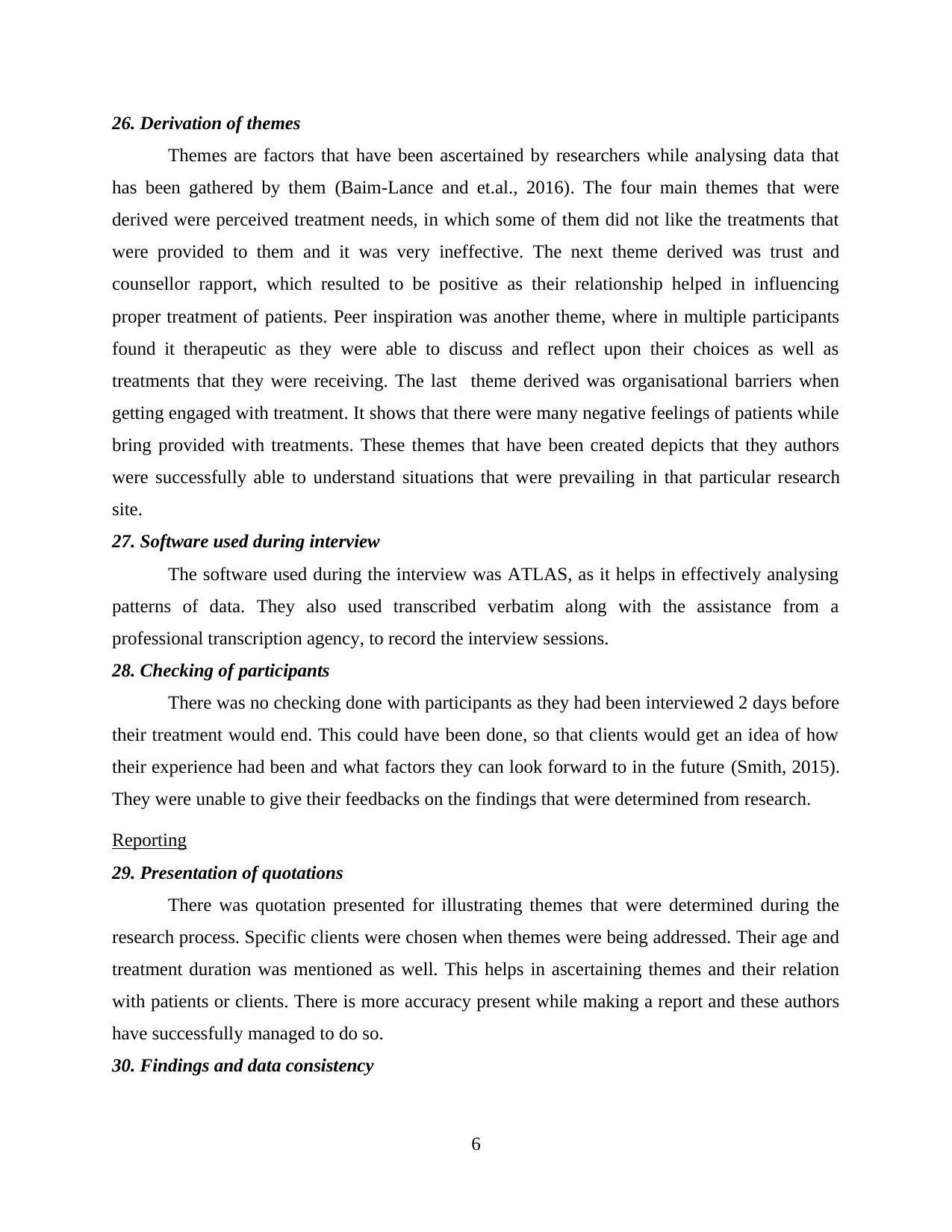
26. Derivation of themes
Themes are factors that have been ascertained by researchers while analysing data that
has been gathered by them (Baim-Lance and et.al., 2016). The four main themes that were
derived were perceived treatment needs, in which some of them did not like the treatments that
were provided to them and it was very ineffective. The next theme derived was trust and
counsellor rapport, which resulted to be positive as their relationship helped in influencing
proper treatment of patients. Peer inspiration was another theme, where in multiple participants
found it therapeutic as they were able to discuss and reflect upon their choices as well as
treatments that they were receiving. The last theme derived was organisational barriers when
getting engaged with treatment. It shows that there were many negative feelings of patients while
bring provided with treatments. These themes that have been created depicts that they authors
were successfully able to understand situations that were prevailing in that particular research
site.
27. Software used during interview
The software used during the interview was ATLAS, as it helps in effectively analysing
patterns of data. They also used transcribed verbatim along with the assistance from a
professional transcription agency, to record the interview sessions.
28. Checking of participants
There was no checking done with participants as they had been interviewed 2 days before
their treatment would end. This could have been done, so that clients would get an idea of how
their experience had been and what factors they can look forward to in the future (Smith, 2015).
They were unable to give their feedbacks on the findings that were determined from research.
Reporting
29. Presentation of quotations
There was quotation presented for illustrating themes that were determined during the
research process. Specific clients were chosen when themes were being addressed. Their age and
treatment duration was mentioned as well. This helps in ascertaining themes and their relation
with patients or clients. There is more accuracy present while making a report and these authors
have successfully managed to do so.
30. Findings and data consistency
6
Themes are factors that have been ascertained by researchers while analysing data that
has been gathered by them (Baim-Lance and et.al., 2016). The four main themes that were
derived were perceived treatment needs, in which some of them did not like the treatments that
were provided to them and it was very ineffective. The next theme derived was trust and
counsellor rapport, which resulted to be positive as their relationship helped in influencing
proper treatment of patients. Peer inspiration was another theme, where in multiple participants
found it therapeutic as they were able to discuss and reflect upon their choices as well as
treatments that they were receiving. The last theme derived was organisational barriers when
getting engaged with treatment. It shows that there were many negative feelings of patients while
bring provided with treatments. These themes that have been created depicts that they authors
were successfully able to understand situations that were prevailing in that particular research
site.
27. Software used during interview
The software used during the interview was ATLAS, as it helps in effectively analysing
patterns of data. They also used transcribed verbatim along with the assistance from a
professional transcription agency, to record the interview sessions.
28. Checking of participants
There was no checking done with participants as they had been interviewed 2 days before
their treatment would end. This could have been done, so that clients would get an idea of how
their experience had been and what factors they can look forward to in the future (Smith, 2015).
They were unable to give their feedbacks on the findings that were determined from research.
Reporting
29. Presentation of quotations
There was quotation presented for illustrating themes that were determined during the
research process. Specific clients were chosen when themes were being addressed. Their age and
treatment duration was mentioned as well. This helps in ascertaining themes and their relation
with patients or clients. There is more accuracy present while making a report and these authors
have successfully managed to do so.
30. Findings and data consistency
6
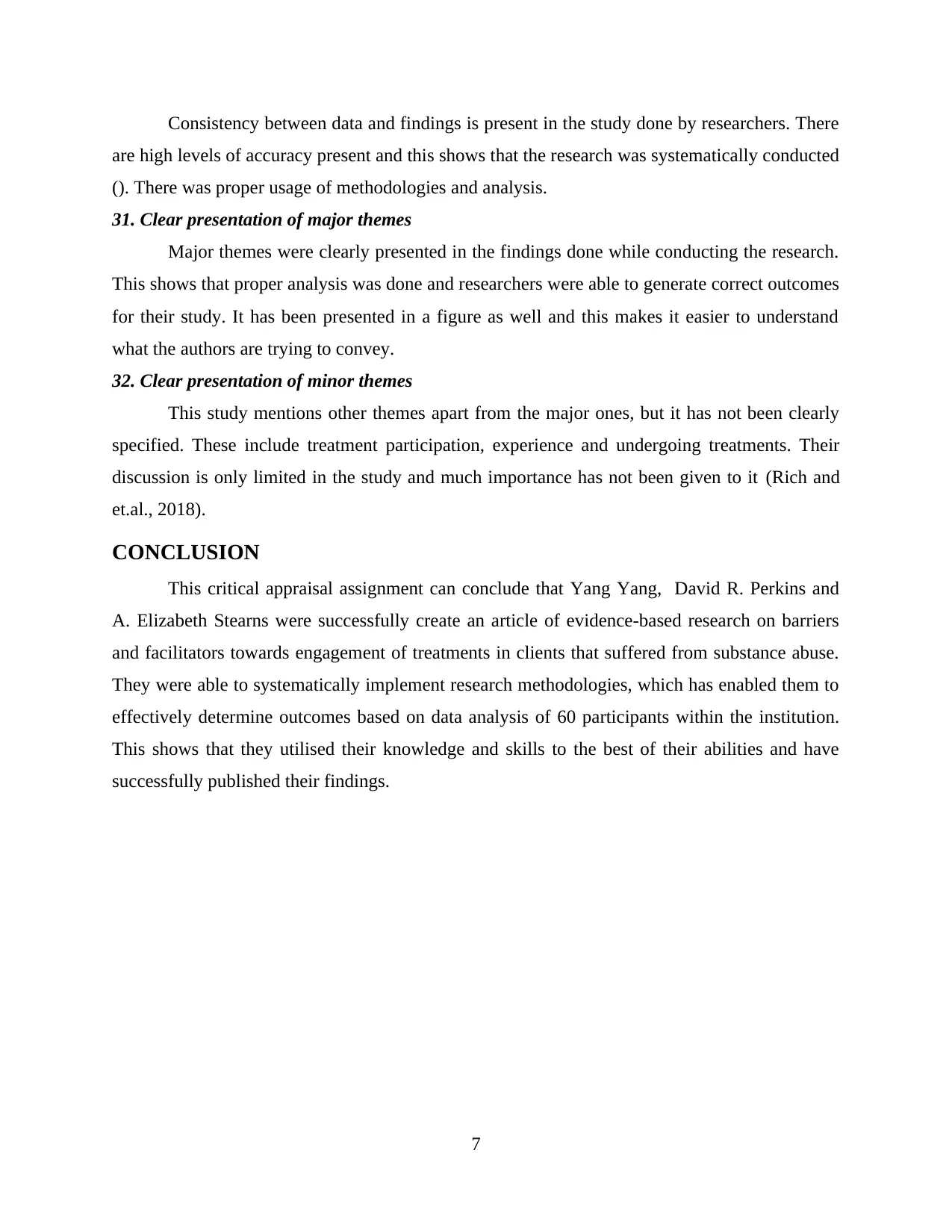
Consistency between data and findings is present in the study done by researchers. There
are high levels of accuracy present and this shows that the research was systematically conducted
(). There was proper usage of methodologies and analysis.
31. Clear presentation of major themes
Major themes were clearly presented in the findings done while conducting the research.
This shows that proper analysis was done and researchers were able to generate correct outcomes
for their study. It has been presented in a figure as well and this makes it easier to understand
what the authors are trying to convey.
32. Clear presentation of minor themes
This study mentions other themes apart from the major ones, but it has not been clearly
specified. These include treatment participation, experience and undergoing treatments. Their
discussion is only limited in the study and much importance has not been given to it (Rich and
et.al., 2018).
CONCLUSION
This critical appraisal assignment can conclude that Yang Yang, David R. Perkins and
A. Elizabeth Stearns were successfully create an article of evidence-based research on barriers
and facilitators towards engagement of treatments in clients that suffered from substance abuse.
They were able to systematically implement research methodologies, which has enabled them to
effectively determine outcomes based on data analysis of 60 participants within the institution.
This shows that they utilised their knowledge and skills to the best of their abilities and have
successfully published their findings.
7
are high levels of accuracy present and this shows that the research was systematically conducted
(). There was proper usage of methodologies and analysis.
31. Clear presentation of major themes
Major themes were clearly presented in the findings done while conducting the research.
This shows that proper analysis was done and researchers were able to generate correct outcomes
for their study. It has been presented in a figure as well and this makes it easier to understand
what the authors are trying to convey.
32. Clear presentation of minor themes
This study mentions other themes apart from the major ones, but it has not been clearly
specified. These include treatment participation, experience and undergoing treatments. Their
discussion is only limited in the study and much importance has not been given to it (Rich and
et.al., 2018).
CONCLUSION
This critical appraisal assignment can conclude that Yang Yang, David R. Perkins and
A. Elizabeth Stearns were successfully create an article of evidence-based research on barriers
and facilitators towards engagement of treatments in clients that suffered from substance abuse.
They were able to systematically implement research methodologies, which has enabled them to
effectively determine outcomes based on data analysis of 60 participants within the institution.
This shows that they utilised their knowledge and skills to the best of their abilities and have
successfully published their findings.
7
Secure Best Marks with AI Grader
Need help grading? Try our AI Grader for instant feedback on your assignments.
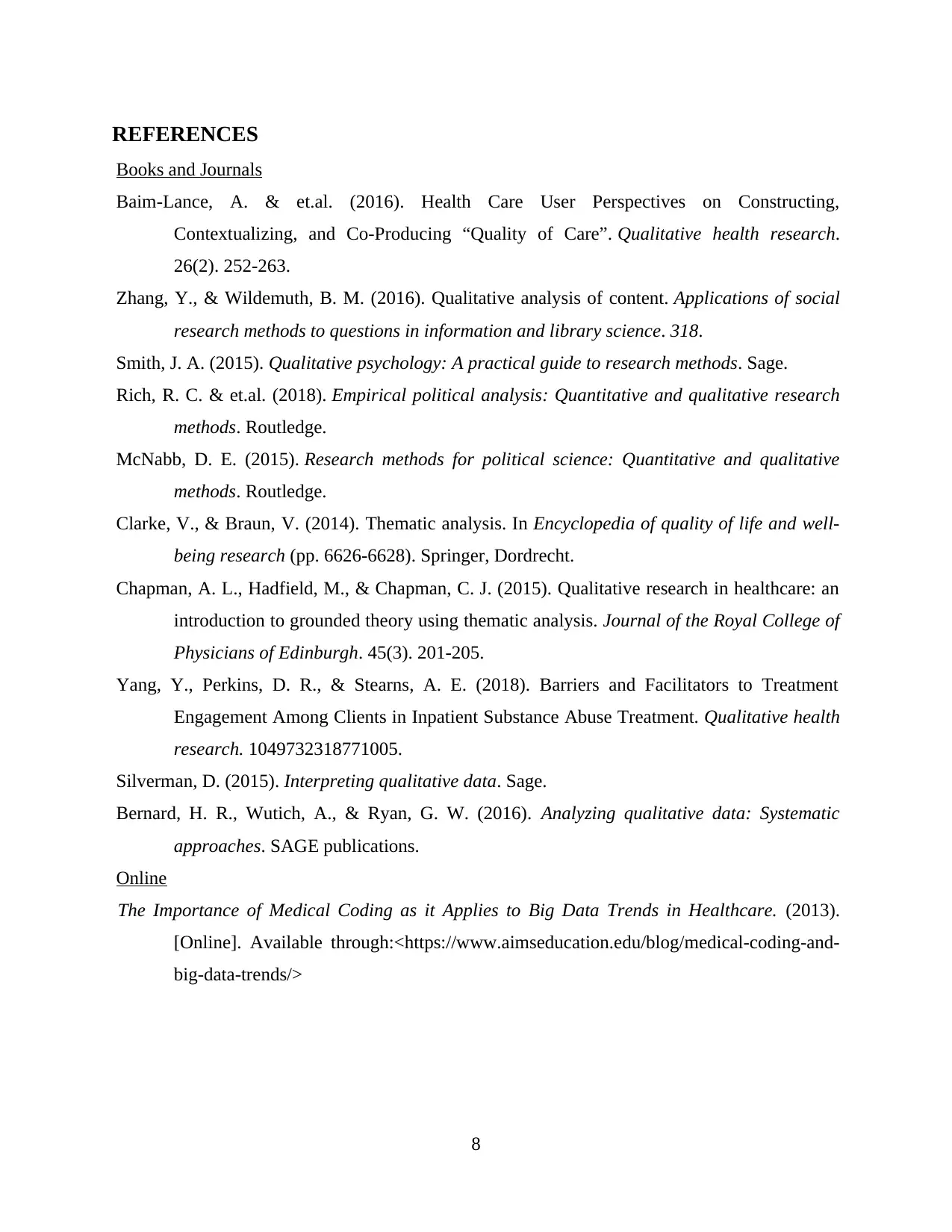
REFERENCES
Books and Journals
Baim-Lance, A. & et.al. (2016). Health Care User Perspectives on Constructing,
Contextualizing, and Co-Producing “Quality of Care”. Qualitative health research.
26(2). 252-263.
Zhang, Y., & Wildemuth, B. M. (2016). Qualitative analysis of content. Applications of social
research methods to questions in information and library science. 318.
Smith, J. A. (2015). Qualitative psychology: A practical guide to research methods. Sage.
Rich, R. C. & et.al. (2018). Empirical political analysis: Quantitative and qualitative research
methods. Routledge.
McNabb, D. E. (2015). Research methods for political science: Quantitative and qualitative
methods. Routledge.
Clarke, V., & Braun, V. (2014). Thematic analysis. In Encyclopedia of quality of life and well-
being research (pp. 6626-6628). Springer, Dordrecht.
Chapman, A. L., Hadfield, M., & Chapman, C. J. (2015). Qualitative research in healthcare: an
introduction to grounded theory using thematic analysis. Journal of the Royal College of
Physicians of Edinburgh. 45(3). 201-205.
Yang, Y., Perkins, D. R., & Stearns, A. E. (2018). Barriers and Facilitators to Treatment
Engagement Among Clients in Inpatient Substance Abuse Treatment. Qualitative health
research. 1049732318771005.
Silverman, D. (2015). Interpreting qualitative data. Sage.
Bernard, H. R., Wutich, A., & Ryan, G. W. (2016). Analyzing qualitative data: Systematic
approaches. SAGE publications.
Online
The Importance of Medical Coding as it Applies to Big Data Trends in Healthcare. (2013).
[Online]. Available through:<https://www.aimseducation.edu/blog/medical-coding-and-
big-data-trends/>
8
Books and Journals
Baim-Lance, A. & et.al. (2016). Health Care User Perspectives on Constructing,
Contextualizing, and Co-Producing “Quality of Care”. Qualitative health research.
26(2). 252-263.
Zhang, Y., & Wildemuth, B. M. (2016). Qualitative analysis of content. Applications of social
research methods to questions in information and library science. 318.
Smith, J. A. (2015). Qualitative psychology: A practical guide to research methods. Sage.
Rich, R. C. & et.al. (2018). Empirical political analysis: Quantitative and qualitative research
methods. Routledge.
McNabb, D. E. (2015). Research methods for political science: Quantitative and qualitative
methods. Routledge.
Clarke, V., & Braun, V. (2014). Thematic analysis. In Encyclopedia of quality of life and well-
being research (pp. 6626-6628). Springer, Dordrecht.
Chapman, A. L., Hadfield, M., & Chapman, C. J. (2015). Qualitative research in healthcare: an
introduction to grounded theory using thematic analysis. Journal of the Royal College of
Physicians of Edinburgh. 45(3). 201-205.
Yang, Y., Perkins, D. R., & Stearns, A. E. (2018). Barriers and Facilitators to Treatment
Engagement Among Clients in Inpatient Substance Abuse Treatment. Qualitative health
research. 1049732318771005.
Silverman, D. (2015). Interpreting qualitative data. Sage.
Bernard, H. R., Wutich, A., & Ryan, G. W. (2016). Analyzing qualitative data: Systematic
approaches. SAGE publications.
Online
The Importance of Medical Coding as it Applies to Big Data Trends in Healthcare. (2013).
[Online]. Available through:<https://www.aimseducation.edu/blog/medical-coding-and-
big-data-trends/>
8
1 out of 11
Related Documents
Your All-in-One AI-Powered Toolkit for Academic Success.
+13062052269
info@desklib.com
Available 24*7 on WhatsApp / Email
![[object Object]](/_next/static/media/star-bottom.7253800d.svg)
Unlock your academic potential
© 2024 | Zucol Services PVT LTD | All rights reserved.


